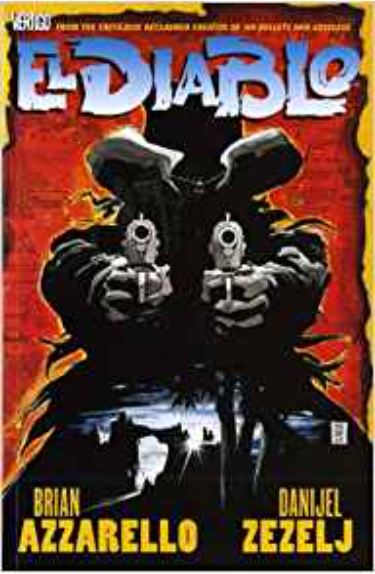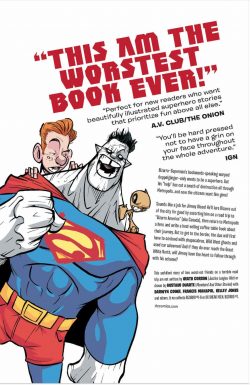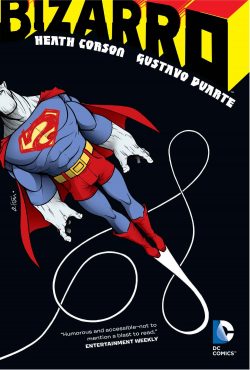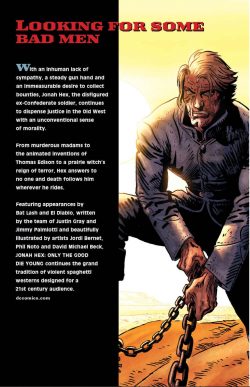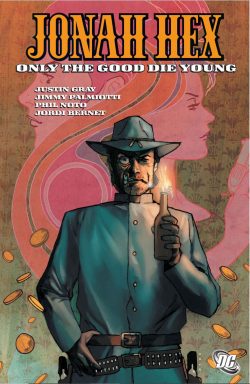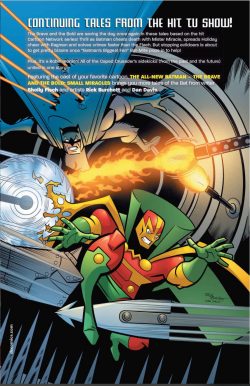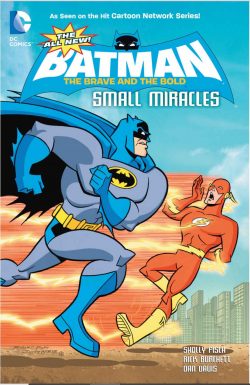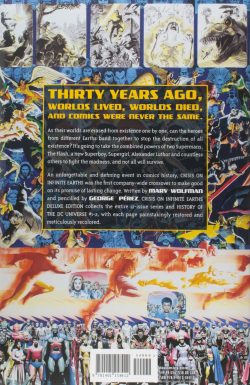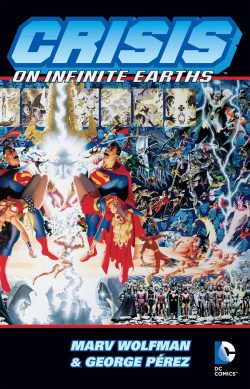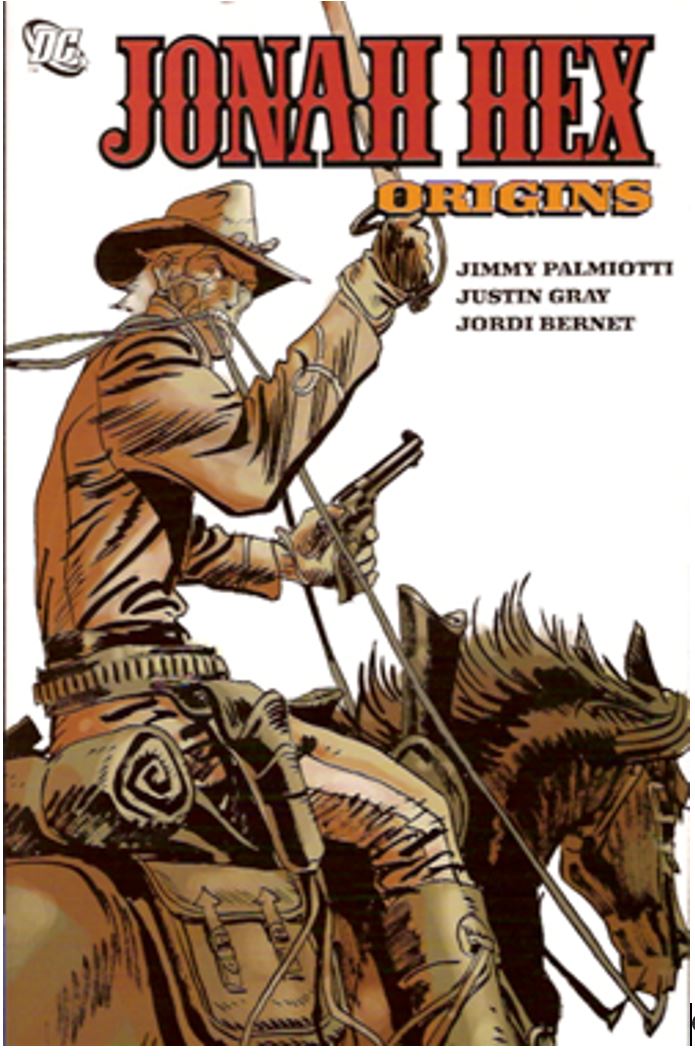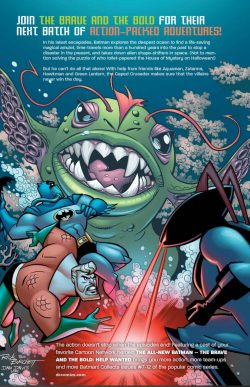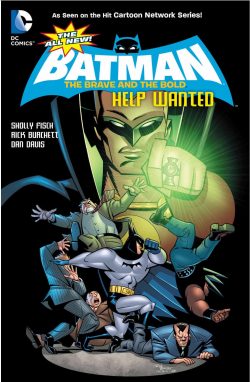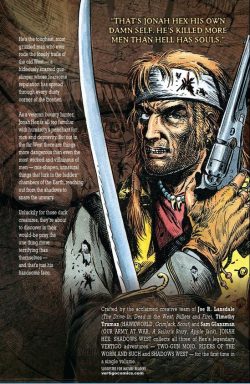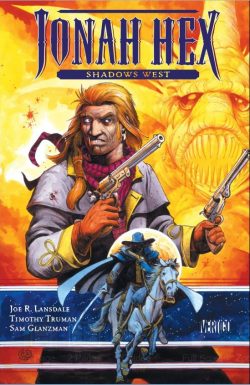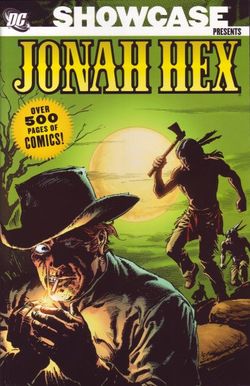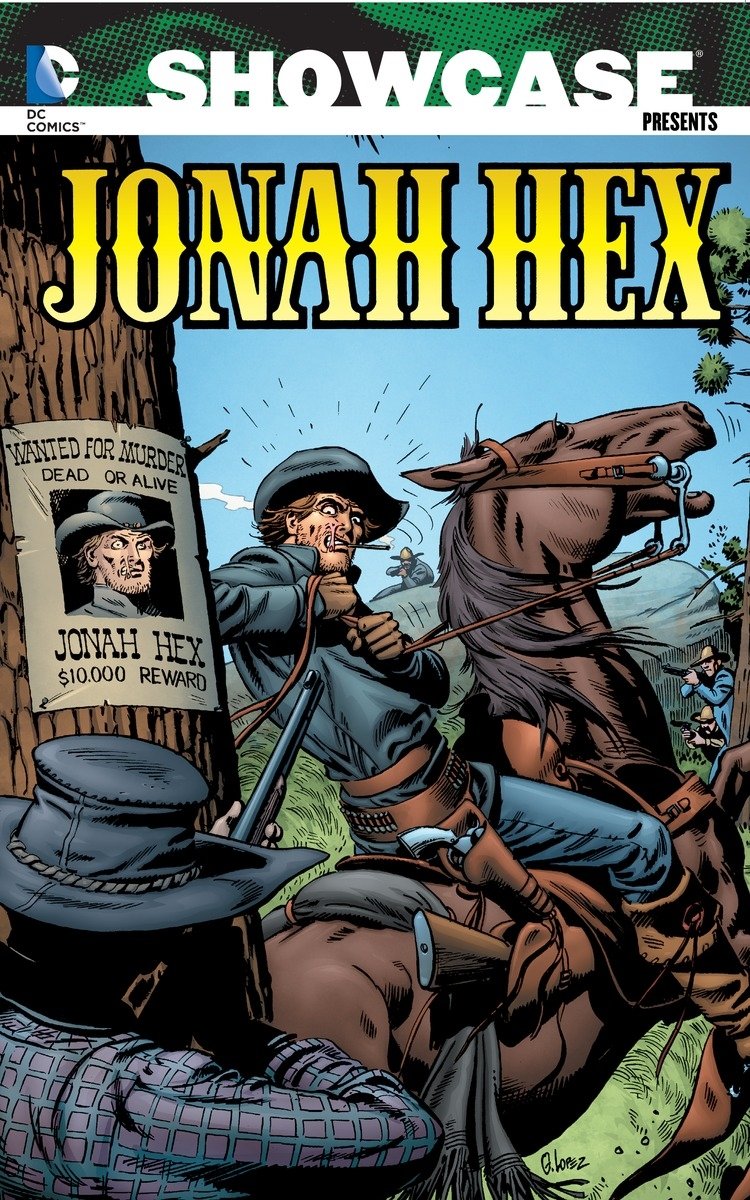
By Michael Fleisher, David Michelinie, John Albano, Jose-Luis García–López, Vicente Alcazar, Ernie Chan, Rich Buckler, Tony DeZuñiga, & various (DC Comics)
ISBN: 978-1-4012-4106-3 (TPB)
The Western is an oddly forgiving genre which can be pragmatically sub-divided into two discrete halves: the sparkly, shiny version that dominated kids’ books, comics and television for nearly a century, best typified by Zane Grey stories and heroes such as Roy Rogers and Gene Autry – and the other stuff…
That sort of cowboy tale is grimy, gritty, excessively dark and nihilistic, and was done best for years by Europeans in such strips as Jean-Michel Charlier’s Lieutenant Blueberry or Bonelli and Galleppini’s Tex Willer before making their way into US culture through the films of Sam Peckinpah and Sergio Leone.
Jonah Hex is the very best of this latter sort.
DC (or National Periodicals as it then as) stocked up a stable (sorry!) of clean-cut gunslingers at the collapse of the superhero genre in 1949, creating such dashing – and highly readable – luminaries as Johnny Thunder, The Trigger Twins, Nighthawk, Matt Savage, Strong Bow and dozens of others in a marketplace that seemed limitless in its voracious hunger for chaps in chaps. All things end, however, and by the early sixties this sagebrush brigade had dwindled to a few venerable properties. The flurry of superheroes increasingly hogged the newsstands during the Silver Age starting as early as 1956, but by the end of the 1960s they were waning again, and thematic changes in the cinematic Cowboy filtered through to a comics industry suffering its second superhero retreat in twenty years…
A critical success, light-hearted Western Bat Lash never secured a solid following, but DC, keen to sustain a genre its dwindling readership could warm to, retrenched and revived an old title, gambling once again on heroes who were no longer simply boy scouts with six-guns.
Cover-dated August/September 1970, All-Star Western (volume 2) #1 launched with Pow-Wow Smith reprints, transforming to an all-new anthology format with its second bi-monthly issue. The title featured many creative big guns, including Robert Kanigher, Neal Adams, Gray Morrow, Al Williamson, Gil Kane, Angelo Torres, and Dick Giordano, working on such strips as Outlaw!, Billy the Kid and cult sleeper-hit El Diablo: combining shoot-’em-up shenanigans with supernatural chills, in unavoidable deference to the real hit genre-type that saved comics in those dark days… supernatural horror.
It wasn’t until the tenth issue and the introduction of a disfigured, irascible and shockingly lethal bounty hunter – created by writer John Albano & Tony DeZuñiga – that the company found its greatest and most enduring Western Warrior…
Jonah Hex is the very model of the modern anti-hero: a coarse, callous, proudly uneducated manhunter. Clad in a battered Confederate Grey tunic and hat with half his face lost to some hideous past injury, he is a brutal thug little better than the scum he hunts – and certainly a man to avoid …or so you’d think on first appearances…
The greatest gunfighter in the world was introduced in ‘Welcome to Paradise’: a powerful thriller with a subtle sting of sentimentality that anyone who has seen the classic western Shane could not fail to appreciate. From the first, Albano constantly hinted at tortured depths hidden behind Hex’s hellishly scarred visage and deadly proficiency…
The comic had been re-titled Weird Western Tales (aligning it with the company’s highly successful horror/mystery line) and subsequent tales of the gunman combined charm, bleak, black comedy and tragedy in equal amounts: a formula that rocketed Hex to the forefront of critical and popular acclaim.
From the very start, the series sought to redress some of the most unpalatable motifs of old style cowboy literature and any fan of films like Soldier Blue and Little Big Man or Dee Brown’s iconoclastic Bury My Heart at Wounded Knee could derive a grim sense of vicarious satisfaction at most of the stories. There was also a huge helping of world-weary cynicism that wasn’t found in other comics until well past the Watergate Scandal, when America as a whole lost its social and political innocence…
Even though Hex was a unique feature from the outset – thanks to the efforts of writers like Albano and Arnold Drake – the series didn’t truly hit its stride until Michael Fleisher (assisted at first by Russell Carley) became lead scripter.
This second superb monochrome tome of Jonah Hex’s grittily unsavoury yet extraordinarily appealing adventures combines his final appearances from Weird Western Tales #34-38 with #1-22 of his own spun-off solo title, collectively ranging from May 1976 to March 1979. As in so many cases, the material here is currently unavailable in modern colour editions, either on paper, or in digital formats, but we can always hope…
In all honesty: the stories may be printed in black-&-white, but here that’s mostly a benefit as the wealth of overseas illustrators employed were masters of line art and their efforts are actually better without the cheap colour used on comics back then.
The previous book revealed how back during the Civil War, whilst fighting for the South, Hex was framed for a massacre at Union prison camp Fort Charlotte. He subsequently became the sole target of a conspiracy led by an aggrieved Southern autocrat Quentin Turnbull. The schemer set a veritable battalion of Confederate veterans and survivors relentlessly on the trail of the man they all considered the worst traitor in the history of the South…
The dark dramas resume with Weird Western Tales #34 (cover-dated May/June 1976) as Michael Fleisher & George Moliterni’s ‘Death of a Bounty Hunter’ reveals the gunslinger being cheated of a bounty by lazy, ruthless rivals who see him as a meal ticket to success. Adding to his irritation, Hex is saddled with a dime novel writer who has paid a lot of money to dog his tracks for “research”. When both annoyances attempt to treacherously exploit Hex, he proves too much for them all…
Next, the wandering gunman fetches up in a law-abiding town with a nasty secret. Even a mercenary like Hex has some scruples, especially when municipal policy involves using a weekly execution of outlaws to boost city coffers. With sideshow attractions and tourist traps thriving, the bounty hunter protests vigorously when an old man he befriended is condemned to be the next cash-cow of a sheriff who is judge, jury and… ‘The Hangman!’ Moreover, Hex’s objections aren’t overruled by legal appeals or commercial considerations…
Fleisher, Bill Draut, Luis Dominguez & Oscar Novelle detail differences between cultures when an old opponent returns in WWT #36. Hired to broker a peace treaty between the Paiute Nation and Washington, Hex is forced to kill someone who doesn’t deserve to die after a cavalry scout’s atrocities almost triggers a bloodbath, leaving the only way to redeem honour through ‘Bigfoot’s Death Song!’…
Hex’s well-intentioned efforts to teach a young man to shoot costs him dearly when he learns he’s been fed a devious sob-story and unleashed a crazed killer in #37. Illustrated by Rich Buckler & Frank Springer, Fleisher’s compact, irony-drenched tale leads to a necessary and final course correction in ‘Requiem for a Gunfighter!’…
Against all odds and industry norms, Jonah Hex – and western comics – were an increasingly viable proposition for DC at this time. Thus, the bounty hunter closed his account in Weird Western Tales #38 – cover-dated January/February 1977 and on sale at the end of 1976. He was promoted to his own eponymous series while the anthology book began (from #39) the adventures of “white Indian” Scalphunter.
Hex’s last WWT exploit was an epic, cynically salutary saga as Fleisher partnered with the magnificently gifted José Luis García–López, whose art would also grace the first issues of Hex’s new home, augmented and followed by many of the superb overseas draughtsmen who’d been hired to draw DC’s horror stories, but who found an equally comfortable fit producing the baroque yet naturalistic adventures of the grungy gunslinger…
‘Track of the Wolf… Claw of the Bear!’ finds Hex hired in the depths of winter to catch a white wolf that has killed a banker. When the beast and the mountain man who lives with it save Jonah from death, their growing friendship unravels a skein of embezzlement and murder, with Hex’s sheepherder clients provoking tragedy and justifiable vengeance…
Jonah Hex #1 launched with a March/April 1977 cover-date, wherein Fleisher & García–López concocted ‘Vengeance for a Fallen Gladiator!’ as the West’s greatest manhunter is hired to find a rich man’s son. The trail leads to a travelling show forcing boys to fight for the delectation of bloodthirsty townsfolk and an unhappy resolution for all involved…
Hex is then forced to infiltrate ‘The Lair of the Parrot’ at the orders of Federal fixer Ned Landon. Flamboyant Mexican bandit El Papagayo is the gunslinger’s supposed target, but after barely escaping with his life, Hex returns to America to discover he’s been framed for the Secret Serviceman’s murder…
Despite having a price on his head, ‘The Fugitive’ still finds time to thwart a vicious land grab for a blind rancher’s home in #3 before more strands of a complex plot are revealed in ‘The Day of the Chameleon!’ as an actor further impersonates Hex: heaping even greater crimes onto the bounty hunter’s ever-escalating-but-unjustified rap-sheet. The plot takes an even more byzantine twist when Hex is briefly sheltered by outcast widow Joanna Mosby, seemingly destroys his evil twin, restores his good name and reels in shock after his most relentless foe reveals who’s behind his current situation…
An expanded reprint of Hex’s debut from All-Star Western #10 follows as Albano, Fleisher, DeZuniga & García–López collectively revisit better days in #5’s ‘Welcome to Paradise’, with a new framing sequence detailing how Hex finds brief respite in Paradise Corners after which he’s caught by aging and honest marshal Toby Ruster: another dutiful innocent dragged down and doomed by association.
Despite having cleared his name, the many wanted posters issued mean Hex is still regarded by many as an outlaw. When a storm deposits ‘The Lawman’ and his captive in an isolated town, Hex almost bluffs his way out of trouble until his ornery nature and hatred of criminals ruins his refuge and triggers another frenzied exit in a convoluted yarn by Fleisher, Ernie Chan & Noly Panaligan…
With Hex still on the run, the same creative team uses the next two issues to finally reveal the manhunter’s origins, beginning in #7 as 13-year old Jonah is sold into slavery by his father. Raised a ‘Son of the Apache’, the white boy becomes a mighty young warrior adopted into the tribe with honour, but cannot escape the jealous schemes of his envious native brother Noh-Tante. How that poisonous rivalry ultimately led to Hex’s escape, rehabilitation and eventual disfigurement with ‘The Mark of the Demon’ adds even greater poignancy to his tragedy-struck saga and shows why the manhunter never quits…
Another diversion drags Hex back over the Mexican Border as he’s tricked into working for the government of President Porfirio Diaz. The gunman is required to escort the recovered golden hoard of the former Empress in ‘The Carlota Conspiracy!’ (illustrated by Chan & Danny Bulanadi), but the vast wealth inevitably draws in old enemy El Papagayo and plenty of brand new double-crossing skunks eager to make a killing…
García–López returns to limn concluding chapter ‘Violence at Veracruz’ in #10, and with bodies dropping everywhere Hex realises he’s been duped from the start and wearily cuts his losses..
Rich Buckler & Dick Giordano illustrate ‘The Holdout!’ as Joanna returns to redeem herself after Hex is maimed and can no longer hold his guns in a cruel tale of card cheats and vengeance, after which ‘The Search for ‘Gator Hawes’ sees the gunman captured by crazed swamp-dwellers obsessed with their rigged “rassling” games, whilst #13’s ‘The Railroad Blaster’ – by David Michelinie & Alcazar – finds the gunslinger hired to stop a saboteur attacking Union Pacific trains. Sadly, he quickly finds himself once again on the wrong side of a painful moral dilemma…
Michelinie then details the saga of ‘The Sin Killer!’ in #14 as Hex encounters old comrade Jedediah Kane: a first class killer who apparently found peace in The Lord and new passion as a travelling preacher. Unfortunately, due to his family being killed in a crossfire, Kane had merely redirected his efforts and now only killed bounty hunters…
Hiding in plain sight as a trick-shot artist, Hex survives ‘Sawdust and Slow Death’ after uncovering a circus’ true purpose as a wandering band of thieves. Framed for the murder of acrobatic rider Sally Colter, he faces the judgement of the freak show before pulling off his own show-stopping climax…
The extended outlaw saga moves to a conclusion as Fleisher rejoins Alcazar for #16’s ‘The Wyandott Verdict’ which opens with Hex being lynched by masked and hooded men. He is saved by pioneering criminologist Tobias Nostrum and his servant, much to the delight of one cautious observer. The Chameleon has dogged Hex for months, awaiting a moment of perfect revenge and takes his chance when the scientist’s new-fangled forensics lead to a trial that could exonerate the bounty hunter…
Warping the entire affair, the deranged actor almost succeeds in dooming Hex, but wasn’t expecting Quentin Turnbull to overplay his own hand in the conspiracy…
Restored and renewed, Hex refuses a commission to ride a hot air balloon in #17 but is still trapped on a ‘Voyage to Oblivion’ when the client won’t take “no” for an answer. His desperate escape lands him aboard a slave ship bound for Brazil and leading a revolt of the human cargo before alone and adrift he lands in a green hell…
Crafted by Fleisher, Val Mayerik & Bulanadi, #18 depicts ‘Amazon Treasure… Amazon Death!’ as the castaway saves a native boy from white rubber plantation owners. The civilised colonisers then try to trick Hex into exterminating the entire indigenous tribe. They aren’t the first to assume the crude, vulgar cowboy is as dumb as he sounds, and like all the rest, don’t live long enough to revise their opinions, once the Indios unleash the horrors of the jungles upon the treasure-hunting interlopers…
With Fleisher & Alcazar crafting the remainder of this volume, #19 introduces ‘The Duke of Zarkania!’ Freshly-returned to the US, Hex is hired by visiting European royalty one step ahead of an accession rival and must battle roving assassins. It’s not long before the manhunter suspects he’s working for the wrong noble and ultimately realises there is no good side in old world affairs…
The bounty hunter’s past rears up to bite him when he foils a stagecoach robbery and inadvertently saves the father who sold him into slavery. The reprobate is unrepentant and as depraved as ever, but still convinces Hex to hire on as guard for a theft-plagued coach company. However, when riding the ‘Phantom Stage to Willow Bend!’ the son yet again learns a life lesson in parenthood as Pa Hex fakes his own death and uses ‘The Buryin’!’ to cover a quarter million dollar robbery. Sadly, he can’t help cheating his own accomplices either, but saves his own skin by “revealing” that Jonah has the money now. Cue more horrific gunplay and even greater familial regret…
The sagebrush sagas are reined in with #22 as ‘Requiem for a Pack Rat!’ explores the repercussions of Hex’s job. When child killer Lobo hangs for his crimes, his brothers come looking for the bounty hunter who brought him in and – caught in the crossfire – an old prospector pal pays the price for knowing Jonah. Shot, broken-legged and left for dead, Hex has to survive the desert and rampaging savages and save a hostage mining family before at last reuniting Lobo with his sinister siblings…
These potent, timeless tales come with a stunning cover gallery from Luis Dominguez, Moliterni, Chan, García–López, Buckler, Frank Springer, Bernie Wrightson, Gray Morrow, Giordano, Jim Starlin and Frank Giacoia: a powerful evocation of a lost era, different tastes and sensibilities that never change but can always surprise.
Jonah Hex is one of the most unique and original characters in cowboy comics: richly ironic, darkly comedic, rousing, chilling and cathartically satisfying. This is a Western for those who despise the form whilst being the perfect modern interpretation of grand storytelling tradition. No matter what your reading preference, this is a collection you don’t want to miss.
© 1976, 1977, 1978, 1979, 2014 DC Comics. All Rights Reserved.
